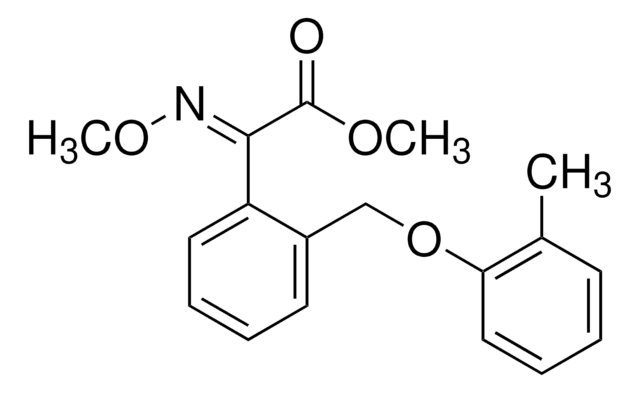45313
Terbufos
PESTANAL®, analytical standard
About This Item
Polecane produkty
klasa czystości
analytical standard
Poziom jakości
linia produktu
PESTANAL®
okres trwałości
limited shelf life, expiry date on the label
metody
HPLC: suitable
gas chromatography (GC): suitable
Zastosowanie
agriculture
environmental
format
neat
temp. przechowywania
2-8°C
ciąg SMILES
CCOP(=S)(OCC)SCSC(C)(C)C
InChI
1S/C9H21O2PS3/c1-6-10-12(13,11-7-2)15-8-14-9(3,4)5/h6-8H2,1-5H3
Klucz InChI
XLNZEKHULJKQBA-UHFFFAOYSA-N
Szukasz podobnych produktów? Odwiedź Przewodnik dotyczący porównywania produktów
Powiązane kategorie
Opis ogólny
Terbufos is not approved for its use in the European Union.
Maximum residue levels (MRLs) have been set according to Reg (EC) No 149/2008 for Terbufos for various products of plant and animal origin 0.01 mg/kg.
Terbufos in its activated form irreversibly inhibits acetylcholinesterase (AChE), leading to the accumulation of acetylcholine, resulting in overstimulation of muscarinic and nicotinic receptors.
Zastosowanie
- Protect and detect two thermolabile metabolites of terbufos, and simultaneously analyze terbufos and its metabolites in pepper and pepper leaf samples using GC-FPD
- Investigate photocatalytic degradation of terbufos in aqueous suspensions using titanium dioxide (TiO2) as a photocatalyst
- Study the effects of different doses of terbufos on the decomposition process and the scavenger flies assemblages composition in Wistar rat carcasses
- Measure adsorption of two commonly used organophosphorus pesticides, Phorate and Terbufos onto four tropical soils
- Examine the acute effects of terbufos and its major oxidation products, alone and in combination with each other or with atrazine, on Ceriodaphnia cf dubia
- Investigate the molecular mechanisms of genotoxicity in HepG2 cells and zebrafish embryos following exposure to terbufos, fenthion, or combinations of these pesticides
Informacje prawne
Hasło ostrzegawcze
Danger
Zwroty wskazujące rodzaj zagrożenia
Zwroty wskazujące środki ostrożności
Klasyfikacja zagrożeń
Acute Tox. 1 Dermal - Acute Tox. 2 Oral - Aquatic Acute 1 - Aquatic Chronic 1
Kod klasy składowania
6.1A - Combustible, acute toxic Cat. 1 and 2 / very toxic hazardous materials
Klasa zagrożenia wodnego (WGK)
WGK 3
Temperatura zapłonu (°F)
Not applicable
Temperatura zapłonu (°C)
Not applicable
Środki ochrony indywidualnej
Eyeshields, Faceshields, Gloves, type ABEK (EN14387) respirator filter
Choose from one of the most recent versions:
Masz już ten produkt?
Dokumenty związane z niedawno zakupionymi produktami zostały zamieszczone w Bibliotece dokumentów.
Klienci oglądali również te produkty
Nasz zespół naukowców ma doświadczenie we wszystkich obszarach badań, w tym w naukach przyrodniczych, materiałoznawstwie, syntezie chemicznej, chromatografii, analityce i wielu innych dziedzinach.
Skontaktuj się z zespołem ds. pomocy technicznej















